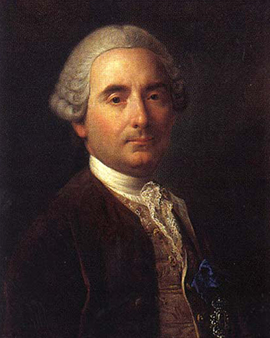In the golden age of art, when canvases shone in their magnificent frames, Count Pietro Antonio Rotari, born in Verona on September 30, 1707 and died in St. Petersburg on August 31, 1762, was a master of painting. He crossed national borders to display his skills in Italy, Vienna, Dresden, and finally in St. Petersburg as a court painter. In the process, he left his viewers a world of portraits that are compelling in both their detail and variety. Born to Sebastiano Rotari, a doctor, and his wife Anna, Pietro Rotari initially discovered painting merely as a pastime. However, under the tutelage of his teacher Antonio Balestra, who quickly recognized the extraordinary talent of the young Pietro, his interest turned into a career. He spent his formative years in various art centers in Italy, studying under masters such as Francesco Trevisani in Rome and Francesco Solimena in Naples, and drawing inspiration from Tizian's and Paolo Veronese's masterpieces in Venice. Back in his hometown of Verona, he established his own studio and school and quickly made a name for himself as a painter of religious paintings.
But Rotari's career had not yet reached its peak. For his services in art, he was awarded the title of count in 1749. He then moved to Dresden via Vienna, where he became a sought-after artist at the court of the Saxon Elector and Polish King August III. An elaborate attempt to obtain a position at the French court failed, and Rotari finally moved to St. Petersburg. There he became a court painter, portraying with great skill Tsarina Elizabeth, Peter III, and Catherine II. His works, especially his series of portraits depicting human passions, adorned the royal halls and reflected society and the court. Despite his far-reaching commissions, he still found time to pass on his expertise to the next generations, teaching artists such as Fedor Stepanovich Rokotov and Alexei Petrovich Antropov.
At Master Prints, we are proud to carry on the legacy of this great artist. By meticulously reproducing his work in the form of fine art prints, we bring the genius of Count Pietro Antonio Rotari to a new audience. Each of our art prints is made with the utmost precision and care to preserve the quality and integrity of the original works. By contributing to the preservation of cultural heritage, we make it possible for the radiance of this artist to remain undiminished through the centuries. Discover the unique art of Count Pietro Antonio Rotari and be enchanted by the beauty and precision of his works.
×





.jpg)
.jpg)
.jpg)
.jpg)
.jpg)
.jpg)
.jpg)
.jpg)
.jpg)
.jpg)
.jpg)
.jpg)
 1760 - (MeisterDrucke-196426).jpg)
 1760 - (MeisterDrucke-196426).jpg)
.jpg)
.jpg)
.jpg)
.jpg)
.jpg)
.jpg)
.jpg)
.jpg)
.jpg)
.jpg)
.jpg)
.jpg)
.jpg)
.jpg)
.jpg)
.jpg)
.jpg)
.jpg)
.jpg)
.jpg)
.jpg)
.jpg)
.jpg)
.jpg)
.jpg)
.jpg)
.jpg)
.jpg)
.jpg)
.jpg)
.jpg)
.jpg)
.jpg)
.jpg)
.jpg)
.jpg)
.jpg)
.jpg)
.jpg)
.jpg)
 of Russia after a painting by Dimitri Gregorievich Levitsky (1735-1822) - (MeisterDrucke-55785).jpg)
 of Russia after a painting by Dimitri Gregorievich Levitsky (1735-1822) - (MeisterDrucke-55785).jpg)
.jpg)
.jpg)
.jpg)
.jpg)
.jpg)
.jpg)
.jpg)
.jpg)
.jpg)
.jpg)
_-_(MeisterDrucke-1470865).jpg)
_-_(MeisterDrucke-1470865).jpg)
.jpg)
.jpg)
.jpg)
.jpg)
.jpg)
.jpg)
.jpg)
.jpg)
.jpg)
.jpg)
.jpg)
.jpg)
.jpg)
.jpg)
.jpg)
.jpg)
.jpg)
.jpg)
.jpg)
.jpg)
.jpg)
.jpg)
.jpg)
.jpg)
.jpg)
.jpg)
.jpg)
.jpg)
.jpg)
.jpg)
.jpg)
.jpg)
.jpg)
.jpg)
.jpg)
.jpg)
.jpg)
.jpg)
.jpg)
.jpg)
.jpg)
.jpg)
.jpg)
.jpg)






